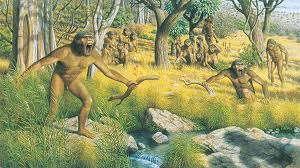I would intuitively argue that evolutionary adaptations, in any species, are more frequently associated with the need to obtain nourishment than with any other need, including sex.
The question of whether the Homo genus trended toward dietary specialisation or generalisation is thus of prime importance in reconstructing our evolution and diet.
The most conspicuous evolutionary adaptation of the genus Homo is the enlargement of the brain. Our brain became three times larger than our predecessors the Australopithecines.
The two competing hypotheses that associate the Homo’s brain expansion with the need to obtain nourishment can be summarised thus:
- Evolution of a large brain enabled Homo to expend its choice of dietary sources to include a wide choice of plants and animals.
- Evolution of a large brain allowed Homo to become a better hunter and thus better specialized at obtaining narrower, meat and fat based diet.
In the proponents of the “variability“ hypothesis I would include beside Peter Ungar also Richard Wrangham with his much publicized “Cooking Hypothesis”. They basically hypothesize that our large brain enabled us to be flexible and collect and prepare (by cooking if need be) a wide variety of plant foods in addition to the meat that, they agree, formed a part of our diet. It must be clear that both talk about early humans that evolved from Australopithecus 2-2.5 million years ago.
No evidence for cooking at that period was ever discovered and no evidence for control of fire but even if cooking existed at the time the question of why we needed such a big brain still remains as cooking could have been aimed primarily at cooking meat.
A paper that was published few days ago in Nature by Balter et al deals directly with the “generalist” versus “specialist” question in human evolution. Balter et al specialize in preforming an analysis of Strontium and Barium residues in fossilized teeth Amyl in relation to Calcium. The relative Amyl content of these residues can identify the animal trophic position, namely herbivores, omnivores or carnivores.
They took advantage of a region in South Africa where three hominids lived possibly side-by-side and in immediate succession. The earliest of the three is Australopithecus africanus who lived between 3 and 2 million years ago. Balter et al’s analysis ties up with earlier analyses of tooth morphology, dental microwear and carbon isotope ratios (see references in the paper). All four methods can be reconciled, according to Balter, with the conclusion that A. africanus was an omnivore who consumed a significant amount of meat.
Regarding the other two, most physical anthropologists would agree that Paranthropus robustus is a descendent of A. africanus and many will bestow that status to the early Homo as well.
Here is the quote concerning the two species from Balter et al’s study:
“…early Homo and P. robustus are indistinguishable from carnivores and browsers respectively”.
In other words early Homo shows the same Sr/Ca and Ba/Ca values that carnivores in that environment do.
And a quote from the end of the abstract:
“A South African scenario is emerging in which the broad ecological niche of Australopithecus became split, and was then occupied by Paranthropus and early Homo, both consuming a lower diversity of foods than Australopithecus.”
In summary, an omnivore, a generalist, who is adapted to consume a wide range of plant and meat resources from the savannah but whose subsequent evolution was in the direction of specialization. One branch, P. robustus, became specialized in certain kind of plants (C4 plants but we shall leave that to another post) and one branch, Homo, specialized in obtaining meat and apparently became a fully fledged carnivore. Since P. robustus maintained his ancestors brain size (400-500 cc) and early Homo increased his brain size (600-900 cc) one can surmise that the need to obtain meat was the reason for that brain expansion. Paradoxically to some, it seems that in order to obtain a wider diet you need a smaller brain. Yes, and it has everything to do with the expensive tissue hypothesis. If you want to consume significant amount of plants in the savannah you can’t afford to have a big brain.
The process of specialisation did not end with early Homo. We showed in our paper (apologising for mentioning it again) that the evolution from H. erectus to H. sapiens might have happened for exactly the same reasons – further specialisation, this time toward obtaining meat from smaller animals.
Previous posts on that subject can be found here, here and here.
Be well
Miki Ben-Dor







 I am a Ph.D. in archaeology, affiliated with the department of Archaeology of Tel Aviv University. I research the connection between human evolution and nutrition throughout human prehistory.
I am a Ph.D. in archaeology, affiliated with the department of Archaeology of Tel Aviv University. I research the connection between human evolution and nutrition throughout human prehistory.

One Response to A new paper in Nature lends support to the evolution of the Homo genus toward specialisation (in hunting)